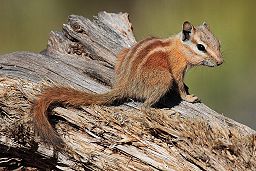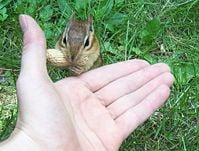Difference between revisions of "Chipmunk" - New World Encyclopedia
Rick Swarts (talk | contribs) (added article from Wikipedia and credit/category tags) |
Rick Swarts (talk | contribs) |
||
| Line 22: | Line 22: | ||
'''Chipmunk''' is the common name for any small [[squirrel]]-like [[rodent]] species of the genus '''''Tamias''''' in the family [[Sciuridae]]. | '''Chipmunk''' is the common name for any small [[squirrel]]-like [[rodent]] species of the genus '''''Tamias''''' in the family [[Sciuridae]]. | ||
| − | == | + | ==Overview== |
| + | |||
| + | '''Squirrel''' is the common name for [[rodent]]s of the family Sciuridae. In everyday speech in the [[English language|English]]-speaking world, it usually refers to [[#Tree squirrels|tree squirrel]]s, which are members of the [[genus|genera]] ''Sciurus'' and ''Tamiasciurus.'' They are indigenous to [[Europe]], [[Asia]], and the Americas. Similar genera are found in [[Africa]]. | ||
| + | |||
| + | The Sciuridae family (squirrel family), called sciurids, also includes [[flying squirrel]]s, and ground squirrels such as the [[#Chipmunk|chipmunk]], [[#Prairie dog|prairie dog]], and [[#marmot|marmot]] (including [[woodchuck]]s). Sciurids are found in all continents except [[Australia]] and [[Antarctica]]. | ||
| + | |||
| + | Sciurids, like all [[rodent]]s, are noted for their [[tooth|teeth]]. They have a pair of large incisors on the upper and one on the lower jaw that grow continuously and need to be kept short and sharpened by frequent gnawing. (The word "rodent" comes from the [[Latin]] word for "gnawing.") The second pair of incisors, the canines, and the first premolars are missing in rodents, creating a gap between the incisors and the grinding teeth. In most squirrels, the incisors are large and the jaw muscles are strong and well developed. | ||
| + | |||
| + | Tamias eutamius now subgenera | ||
| + | |||
| + | |||
| + | |||
| + | |||
| + | |||
Tamias is [[Latin]] for "storer," a reference to the animals' habit of collecting and storing food for winter use.<ref>{{cite book | author = John O. Whitaker, Jr. | coauthors = Robert Elman | title = The Audubon Society Field Guide to North American Mammals | edition = 2nd edition | year = 1980 | publisher= [[Knopf]] | location=New York | isbn= 0-394-50762-2 | pages=370}}</ref> Twenty-five species belong to this family,<ref>{{cite web | url = http://nmnhgoph.si.edu/msw/ | title = Mammal Species of the World (MSW) | accessdate = 2007-06-27 | author = Wilson, D. E. | coauthors = D. M. Reeder | year = 2005 }}</ref> with one species in northeastern [[Asia]], one in eastern [[North America]], and the rest native to western North America. | Tamias is [[Latin]] for "storer," a reference to the animals' habit of collecting and storing food for winter use.<ref>{{cite book | author = John O. Whitaker, Jr. | coauthors = Robert Elman | title = The Audubon Society Field Guide to North American Mammals | edition = 2nd edition | year = 1980 | publisher= [[Knopf]] | location=New York | isbn= 0-394-50762-2 | pages=370}}</ref> Twenty-five species belong to this family,<ref>{{cite web | url = http://nmnhgoph.si.edu/msw/ | title = Mammal Species of the World (MSW) | accessdate = 2007-06-27 | author = Wilson, D. E. | coauthors = D. M. Reeder | year = 2005 }}</ref> with one species in northeastern [[Asia]], one in eastern [[North America]], and the rest native to western North America. | ||
| + | |||
| + | |||
| + | number of species ... ADW lists 25 | ||
| + | |||
The name originally may have been spelled "chitmunk" (from the [[Anishinaabe language#Nishnaabemwin|Odawa]] word ''jidmoonh'', meaning "red squirrel"; ''c.f.'' [[Anishinaabe language#Anishinaabemowin|Ojibwe]], ''ajidamoo''). However, the earliest form cited in the Oxford English Dictionary (from 1842) is "chipmonk". Other early forms include "chipmuck" and "chipminck", and in the 1830s they were also referred to as "chip squirrels," possibly in reference to the sound they make. They are also called "striped squirrels" or "ground squirrels," though the name "ground squirrel" more often refers to the genus ''[[Spermophilus]]''. ''Tamias'' and ''Spermophilus'' are only two of the 13 [[genus|genera]] of ground-living [[Sciuridae|sciurids]]. | The name originally may have been spelled "chitmunk" (from the [[Anishinaabe language#Nishnaabemwin|Odawa]] word ''jidmoonh'', meaning "red squirrel"; ''c.f.'' [[Anishinaabe language#Anishinaabemowin|Ojibwe]], ''ajidamoo''). However, the earliest form cited in the Oxford English Dictionary (from 1842) is "chipmonk". Other early forms include "chipmuck" and "chipminck", and in the 1830s they were also referred to as "chip squirrels," possibly in reference to the sound they make. They are also called "striped squirrels" or "ground squirrels," though the name "ground squirrel" more often refers to the genus ''[[Spermophilus]]''. ''Tamias'' and ''Spermophilus'' are only two of the 13 [[genus|genera]] of ground-living [[Sciuridae|sciurids]]. | ||
Revision as of 02:51, 27 November 2007
- This article is about the animal. For the military training aircraft, see De Havilland Chipmunk. For the fictional musical group, see The Chipmunks.
| Chipmunks
| ||||||||||||||
|---|---|---|---|---|---|---|---|---|---|---|---|---|---|---|
 Tamias rufus
| ||||||||||||||
| Scientific classification | ||||||||||||||
| ||||||||||||||
Chipmunk is the common name for any small squirrel-like rodent species of the genus Tamias in the family Sciuridae.
Overview
Squirrel is the common name for rodents of the family Sciuridae. In everyday speech in the English-speaking world, it usually refers to tree squirrels, which are members of the genera Sciurus and Tamiasciurus. They are indigenous to Europe, Asia, and the Americas. Similar genera are found in Africa.
The Sciuridae family (squirrel family), called sciurids, also includes flying squirrels, and ground squirrels such as the chipmunk, prairie dog, and marmot (including woodchucks). Sciurids are found in all continents except Australia and Antarctica.
Sciurids, like all rodents, are noted for their teeth. They have a pair of large incisors on the upper and one on the lower jaw that grow continuously and need to be kept short and sharpened by frequent gnawing. (The word "rodent" comes from the Latin word for "gnawing.") The second pair of incisors, the canines, and the first premolars are missing in rodents, creating a gap between the incisors and the grinding teeth. In most squirrels, the incisors are large and the jaw muscles are strong and well developed.
Tamias eutamius now subgenera
Tamias is Latin for "storer," a reference to the animals' habit of collecting and storing food for winter use.[1] Twenty-five species belong to this family,[2] with one species in northeastern Asia, one in eastern North America, and the rest native to western North America.
number of species ... ADW lists 25
The name originally may have been spelled "chitmunk" (from the Odawa word jidmoonh, meaning "red squirrel"; c.f. Ojibwe, ajidamoo). However, the earliest form cited in the Oxford English Dictionary (from 1842) is "chipmonk". Other early forms include "chipmuck" and "chipminck", and in the 1830s they were also referred to as "chip squirrels," possibly in reference to the sound they make. They are also called "striped squirrels" or "ground squirrels," though the name "ground squirrel" more often refers to the genus Spermophilus. Tamias and Spermophilus are only two of the 13 genera of ground-living sciurids.
Ecology and life history
Eastern chipmunks mate in early spring and again in early summer, producing litters of four or five young twice each year. Western chipmunks only breed once a year. The young emerge from the burrow after about six weeks and strike out on their own within the next two weeks.
Though they are commonly depicted with their paws up to the mouth, eating peanuts, or more famously their cheeks bulging out on either side, chipmunks eat a variety of foods. Their omnivorous diet consists of grain, nuts, birds' eggs, fungi, worms, and insects. At the beginning of autumn, many species of chipmunk begin to stockpile these goods in their burrows, for winter. Other species make multiple small caches of food. These two kinds of behavior are called larder hoarding and scatter hoarding. Larder hoarders usually live in their nests until spring.

These small squirrels fulfill several important functions in forest ecosystems. Their activities harvesting and hoarding tree seeds play a crucial role in seedling establishment. They consume many different kinds of fungi, including those involved in symbiotic mycorrhizal associations with trees, and are an important vector for dispersal of the spores of subterranean sporocarps (truffles) which have co-evolved with these and other mycophagous mammals and thus lost the ability to disperse their spores through the air.
Chipmunks play an important role as prey for various predatory mammals and birds, but are also opportunistic predators themselves, particularly with regard to bird eggs and nestlings. In Oregon, Mountain Bluebirds (Siala currucoides) have been observed energetically mobbing chipmunks that they see near their nest trees.
Chipmunks construct expansive burrows which can be more than 3.5 m in length with several well-concealed entrances. The sleeping quarters are kept extremely clean as shells and feces are stored in refuse tunnels.
If unmolested they often become bold enough to take food from the hands of humans. The temptation to pick up or pet any wild animal should be strictly avoided, however. While rabies is exceptionally rare (if not non-existent) in rodents, chipmunk bites can transmit virulent and dangerous bacterial infections.
Species
|
|
ReferencesISBN links support NWE through referral fees
- ↑ John O. Whitaker, Jr. and Robert Elman (1980). The Audubon Society Field Guide to North American Mammals, 2nd edition, New York: Knopf, 370. ISBN 0-394-50762-2.
- ↑ Wilson, D. E.; D. M. Reeder (2005). Mammal Species of the World (MSW). Retrieved 2007-06-27.
- Nichols, John D. and Earl Nyholm (1995). A Concise Dictionary of Minnesota Ojibwe. Minneapolis: University of Minnesota Press.
External links
Credits
New World Encyclopedia writers and editors rewrote and completed the Wikipedia article in accordance with New World Encyclopedia standards. This article abides by terms of the Creative Commons CC-by-sa 3.0 License (CC-by-sa), which may be used and disseminated with proper attribution. Credit is due under the terms of this license that can reference both the New World Encyclopedia contributors and the selfless volunteer contributors of the Wikimedia Foundation. To cite this article click here for a list of acceptable citing formats.The history of earlier contributions by wikipedians is accessible to researchers here:
The history of this article since it was imported to New World Encyclopedia:
Note: Some restrictions may apply to use of individual images which are separately licensed.

